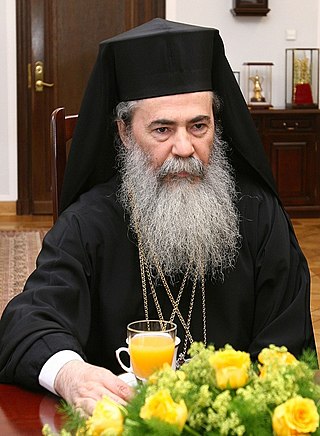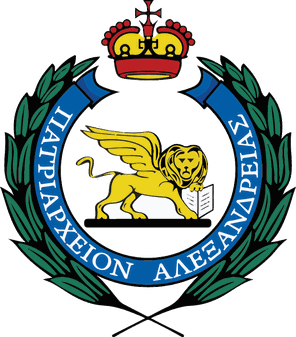See also
- HolyC, the system programming language in TempleOS
The Holy See is the apostolic episcopal see of the bishop of Rome, known as the Pope.
Holy See may also refer to:
The Eastern Orthodox Church, officially the Orthodox Catholic Church, is a communion composed of up to seventeen separate autocephalous (self-governing) hierarchical churches that profess Eastern Orthodoxy and recognise each other as canonical (regular) Eastern Orthodox Christian churches.
The highest-ranking bishops in Eastern Orthodoxy, Oriental Orthodoxy, the Catholic Church, the Hussite Church, Church of the East, and some Independent Catholic Churches are termed patriarchs.

Patriarchate is an ecclesiological term in Christianity, designating the office and jurisdiction of an ecclesiastical patriarch. According to Christian tradition three patriarchates were established by the apostles as apostolic sees in the 1st century: Rome, Antioch, and Alexandria. Constantinople was added in the 4th century and Jerusalem in the 5th century. Eventually, together, these five were recognised as the pentarchy by the Council of Chalcedon in 451.

The Patriarch of Alexandria is the archbishop of Alexandria, Egypt. Historically, this office has included the designation "pope".

The Greek Orthodox patriarch of Jerusalem or Eastern Orthodox patriarch of Jerusalem, officially patriarch of Jerusalem, is the head bishop of the Greek Orthodox Patriarchate of Jerusalem, ranking fourth of nine patriarchs in the Eastern Orthodox Church. Since 2005, the Eastern Orthodox patriarch of Jerusalem has been Theophilos III. The patriarch is styled "Patriarch of the Holy City of Jerusalem and all Holy Land, Syria, beyond the Jordan River, Cana of Galilee, and Holy Zion." The patriarch is the head of the Brotherhood of the Holy Sepulchre, and the religious leader of about 130,000 Eastern Orthodox Christians in the Holy Land, most of them Palestinians.
The Patriarch of Antioch is a traditional title held by the bishop of Antioch. As the traditional "overseer" of the first gentile Christian community, the position has been of prime importance in Pauline Christianity from its earliest period. This diocese is one of the few for which the names of its bishops from the apostolic beginnings have been preserved. Today five churches use the title of patriarch of Antioch: one Oriental Orthodox ; three Eastern Catholic ; and one Eastern Orthodox.

The Greek Orthodox Patriarchate of Antioch, also known as the Antiochian Orthodox Church and legally as the RūmOrthodox Patriarchate of Antioch and All the East, is an autocephalous Greek Orthodox church within the wider communion of Eastern Orthodox Christianity and one of the historic Pentarchy. Headed by the Greek Orthodox patriarch of Antioch, it considers itself the successor to the Christian community founded in Antioch by the Apostles Peter and Paul. It is one of the largest Christian denominations of the Middle East, alongside the Copts of Egypt and the Maronites of Lebanon.

The Latin patriarch of Antioch was a prelate of the Latin Church created in 1098 by Bohemond I of Taranto, founder of the Principality of Antioch, one of the crusader states.
Patriarchate, Archdiocese, Diocese, Territory, or Exarchate of Jerusalem may refer to:
The title of patriarchs of the East is used by primates of several Christian denominations within Eastern Christianity. Historically, the title originated as ecclesiastical designation for primates of the Church of the East. It was, and still is, officially used by different branches of the historical Church of the East.

Pentarchy is a model of Church organization formulated in the laws of Emperor Justinian I of the Roman Empire. In this model, the Christian Church is governed by the heads (patriarchs) of the five major episcopal sees of the Roman Empire: Rome, Constantinople, Alexandria, Antioch, and Jerusalem.

Alphabetical list of Eastern Christianity-related articles on English Wikipedia
Greek Patriarchate may refer to:

The Greek OrthodoxPatriarchate of Alexandria and all Africa, also known as the Greek Orthodox Church of Alexandria, is an autocephalous patriarchate that is part of the Eastern Orthodox Church. Its seat is in Alexandria and it has canonical responsibility for the entire African continent.
In Christianity, the concept of an Apostolic Throne refers to one of the historic Patriarchates that was associated with a specific apostle. Not all of the apostles are associated with specific "thrones"; in general, the phrase applies to Apostles that presided over a specific geographic church. Notably, there is no apostolic throne associated with St. Paul, who along with St. Peter was present, at different times, in both Antioch and Rome (where both Peter and Paul were crucified. The phrase is also somewhat interchangeable with the "Apostolic See".

Patriarch Meletius II Doumani
Patriarchate of Constantinople generally refers to the Ecumenical Patriarchate of Constantinople, the seniormost authority in the Eastern Orthodox Church, led by the Ecumenical Patriarch of Constantinople. The diocese of Constantinople is alleged to have originated with Andrew the Apostle's visit in 38, and has been formally designated as Patriarchate since 531. Its seat is the city successively known as Byzantium, Constantinople, and now Istanbul, Turkey.
The Patriarchate of Antioch is the office and jurisdiction of the bishop or Patriarch of Antioch, the Christian Church's oldest episcopal see, tracing its origin to Saint Peter and originally located in Antioch, now Antakya in Turkey. It has been formally designated as Patriarchate since 531. Several traditions have claimed succession of the early Church of Antioch, none of which however has been based in Antioch/Antakya for centuries:
The Patriarchate of Alexandria is the office and jurisdiction of the bishop of Alexandria in Egypt, referred to since 531 as Patriarch of Alexandria. It originated from Mark the Evangelist and developed until the Council of Chalcedon in 451 when it split into parallel Chalcedonian and Miaphysite traditions, which then competed for the position for several decades before permanently parting ways in 536:
The term Catholic Patriarchate of Alexandria may refer to: